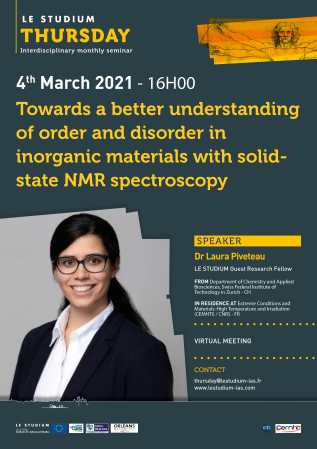Dr Laura Piveteau

Établissement d'origine
Department of Chemistry and Applied Biosciences, ETH Zurich - CH
Laboratoire d'accueil
Conditions Extrêmes et Matériaux : Haute Température et Irradiation (CEMHTI) / CNRS - FR
Hôte scientifique
Dr Dominique Massiot
PROJET
NMR study of disordered inorganic materials using spin diffusion
The goal of this research project, which is going to be conducted in the group of Dominique Massiot at CNRS in Orléans, is to obtain a better understanding of chemical, geometrical and topological order in complex, disordered inorganic materials. Building on the atomic or molecular scale resolution obtained from state-of-the-art nuclear magnetic resonance (NMR) experiments, we want to develop solid-state NMR experiments based on spin diffusion to extend the accessible spatial distance between nuclei to be correlated and thus characterize inorganic solids at the nanoscale.
NMR is a method of choice to study amorphous and disordered materials, and spin diffusion has proven to be very powerful to characterize organic polymers and protein structures revealing short and middle range structural characteristics in the size range of several Angstroms up to few nanometers, which is not or poorly accessible by other analytical methods. However, inorganic samples which do not contain any protons exhibit only very inefficient spin diffusion, which has been seldom observed or eventually becomes unobservable when the dipolar interactions are averaged out by magic angle spinning. Nevertheless, a recent publication by the Emsley group (Björgvinsdóttir et al. J. Am. Chem. Soc. 2018, 140, 7946-7951), taking benefit of surface enhanced dynamic nuclear polarization (DNP), reports efficient spin diffusion in proton-free inorganic solids from surface to the bulk. This finding prompts the prospect to be able to develop solid-state NMR experiments to observe spin diffusion in inorganic materials and to study their structural, compositional and morphological properties at larger spatial scales than previously possible.
For this purpose, we intend to synthesize well-defined alkaline earth silicate and alumino-silicate materials (MO-Al2O3-SiO2, M = Ca, Sr) of progressively increasing structural and chemical complexity and to determine, describe and quantify the nature of chemical and structural order and disorder at the nanometer length scale by putting to work and studying the mechanism of spin diffusion within these materials. To this end, spin diffusion models will be built, and simulations of the systems will be conducted. Then, we will turn to more complex samples with the intention to obtain insights into poorly understood inorganic materials, such as transparent, polycrystalline M1+x/2Al2+xSi2-xO8 (M = Ca, Sr; 0 < x < 0.4) ceramics, by shedding light for example on their species distribution, interatomic connectivity and morphology. The spin diffusion models will be validated and checked for their robustness. We will work towards a satisfactory outcome of the control experiments as well as towards a simple, practical use of the developed NMR methodologies, in the hope for this type of analysis to develop into a more broadly applicable approach to characterize disorder at the nanoscale in inorganic materials.

